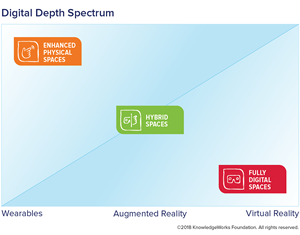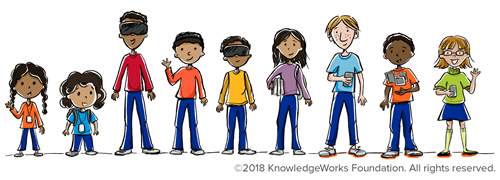In my previous post, “How wearables, AR, and VR help students develop SEL skills (part 1),” I explored the ways in which wearables, augmented reality (AR), and virtual reality (VR) show promise in helping to cultivate social-emotional skills. All three technologies have been greeted with excitement by both the consumer market and many education stakeholders. While these technologies have great potential to support learning in new and novel ways, it is not a given that they will live up to the anticipation surrounding them. As expectations continue to build, educators can begin thinking through the various ways that they might be employed most effectively for learning.
KnowledgeWorks’ strategic foresight publication, Leveraging Digital Depth for Responsive Learning Environments: Future Prospects for Wearables, Augmented Reality, and Virtual Reality, explores how wearables, AR, and VR might be used to create responsive learning environments that can help with the cultivation of social-emotional skills. The publication proposes that educators think about possible uses of wearables, AR, and VR by first considering the types of environments these technologies can create and how they might support student learning. To help educators think about possibilities for these technologies in learning the paper presents a framework called the digital depth spectrum which consists of three kinds of spaces:
- Enhanced physical spaces alter the physical world by applying a thin layer digital information capture, sharing, and feedback.
- Hybrid spaces use multiple digital layers and more extensive computer-generated content, connectivity, and experiences to enable experiences that have a higher degree of digital immersion but which are still anchored in physical space.
- Fully digital spaces provide full immersion in digitally created environments with little reference to physical space.

The digital depth spectrum can be applied to learning design by helping educators think through how different levels of digital depth and their associated technologies might support learning by considering questions such as:
- How might enhanced physical spaces and personal feedback provided by wearables help cultivate students’ self-knowledge and agency and support their academic performance?
- How might hybrid spaces support students’ understanding of complex concepts?
- How might experiences that enable the immersion and embodiment offered by hybrid and fully digital spaces support the development of perspective taking, empathy, and social-emotional skills?
Educators can also use the digital depth spectrum as they consider how to use wearables, AR, and VR beyond lesson design by considering questions such as:
- How might different levels of digital depth help extend or leverage the contributions of educators in your setting?
- How might hybrid or full digital spaces be used to provide access to human resources (experts, professional practitioners, or specialist teachers) that would otherwise be inaccessible?
- What kinds of physical resources might be enhanced or simulated with digital depth technologies?
As wearables, AR, and VR are used more and more for learning, it will be increasingly important for educators to see past the hype. By assessing the potential uses of these technologies, educators can leverage them to help create responsive learning environments for the learners whom they serve. To explore further, download Leveraging Digital Depth for Responsive Learning Environments: Future Prospects for Wearables, Augmented Reality, and Virtual Reality or the accompanying poster.
- 5 obstacles AI can help schools overcome - April 16, 2024
- Guidance counselors could help female high schoolers erase the STEM gender gap - April 16, 2024
- How video coaching inspires teacher self-reflection - April 15, 2024

